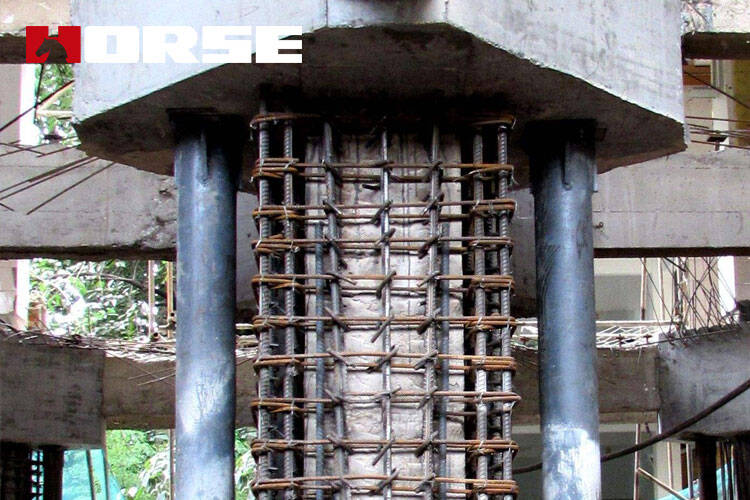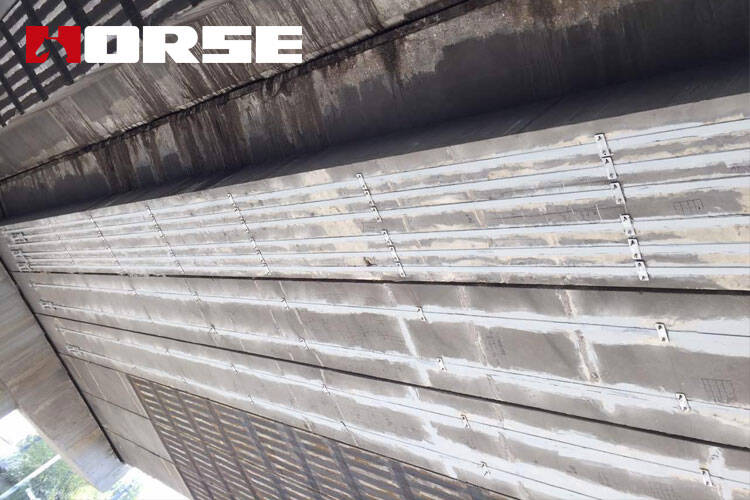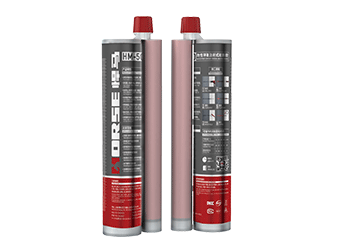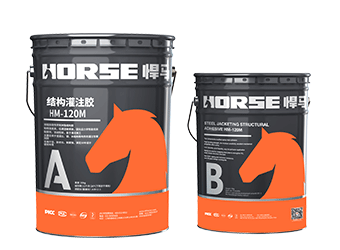Solutions
Horse Construction offers full range of structural strengthening materials with technical supports, documentation supports, products supports, project supports.
Reinforcement Method for Insufficient Beam Bearing Capacity
Repairing and strengthening old buildings is an important aspect of the sustainable development of the construction industry. In view of the insufficient bearing capacity of reinforced concrete beams in old buildings, 6 commonly used reinforcement methods are introduced. Enlarged beam section reinforcement method, outer steel reinforcement method, pasted steel plate reinforcement method, externally pasted carbon fiber cloth reinforcement method, changed beam transmission path reinforcement method, and external prestress reinforcement method, etc.

1 Enlarge the beam section reinforcement method
The reinforcement method of increasing the beam section refers to increasing the main reinforcement, shotcrete, cast-in-place concrete, and outer concrete to increase the size of the concrete beam section. The purpose of using this method is to increase the moment of inertia or geometric flexural modulus of the beam section, reduce the stress of the beam section by changing the section area, and achieve the purpose of strengthening.
Enlarged section reinforcement method has simple construction technology, strong adaptability, and mature design and construction experience. However, the wet work on site construction takes a long time, which will have a certain impact on production and life, and the headroom of the reinforced building will be reduced to a certain extent.

2 External steel reinforcement method
The steel-clad reinforcement method refers to the method of reinforcing steel in the concrete beam called Zhou Baoyi, which can be divided into two forms: dry-clad steel method and wet-clad steel method. When the steel and concrete beams are bonded by chemical adhesive, it is called wet-clad steel method, and when there is no bonding, it is called dry-clad steel method.
The steel-clad method for strengthening concrete beams has the advantages of large reinforcement range and wide application range, but there are also large differences between design calculations and actual force conditions, high requirements for joint processing, large amount of steel, and relatively high cost of reinforcement construction Higher limitations. In order to ensure the stress transmission, the two ends must be reliably anchored to the stressed column when strengthening the beam by the steel-clad method. This often results in some additional column-clad steel costs in actual projects, so this method is more suitable for beams and columns. Used in reinforcement projects. In theory, this reinforcement method is suitable for strengthening any beams with insufficient strength, but in actual projects, it is necessary to balance the reinforcement effect, reinforcement range and cost. In the following situations, this approach is more appropriate:
1) When beams and columns need to be reinforced at the same time, especially when the strength of the beam itself is very low, it should be selected first;
2) When the beam defects are widely distributed, the range of reinforcement is large, and the cost of reinforcement by other methods is higher, and the cost of reinforcement by the outer steel method is relatively low;
3) When the structure at both ends of the girder can provide good anchoring conditions, and the girder needs to be reinforced with a large extent, it can also be used;
4) Although the beam needs to be reinforced, the beam and column need to be reinforced at the same time, and the cost is relatively low or the construction conditions are better when the beam is reinforced by the outer steel method.

3 Sticking steel plate reinforcement method
The method of sticking steel plate reinforcement is to stick the steel plate to the appropriate position outside the reinforced concrete member through the adhesive (building structural glue) when the bearing capacity of the reinforced concrete member is insufficient or the normal use of the structure is affected by excessive deformation or cracks. A technical measure to meet structural bearing capacity requirements or normal use requirements.
The method of sticking steel plate reinforcement has the advantages of not affecting the appearance of reinforced concrete members, short construction period of reinforcement, and quick effect, but it also has disadvantages such as complex construction, high quality requirements, and high reinforcement unit price. Before the construction of the girder is pasted with the steel plate, according to the reinforcement mechanism, it is required to restore the deformation of the girder under the load, that is, unloading work. This is difficult in many cases. The following is a list of situations where this approach is appropriate and inappropriate:
1) If it is required that the appearance of the girders after reinforcement is not affected, and the reinforcement cost is the second, the steel plate method must be used for reinforcement;
2) The beam has cracks due to accidental factors, and its usability will not be affected, but when the safety level is low, the use of sticking steel plate method for reinforcement has the advantages of less engineering and relatively low cost;
3) The sticking steel plate method is suitable for the reinforcement of the girder under static force, and the ambient temperature is not more than 60℃, the relative humidity is not more than 70%, and there is no chemical corrosion influence;
4) When the rigidity of the beam section is too low, and the beam cracks are distributed widely and the width is large, this method is not suitable for reinforcement;
5) When the component concrete strength grade is lower than C15, the reinforcement technical specifications require that this method is not used for reinforcement.

4 Extrnally bonded carbon fiber reinforcement method
The sticking carbon fiber cloth reinforcement method refers to the use of high-performance adhesives to stick carbon fiber cloth (ie CFRP) on the outer surface of the beam. Make the two work together to improve the load-bearing capacity of the beam (bending resistance and shear resistance) to achieve the purpose of strengthening the beam.
The use of carbon fiber cloth reinforcement has high strength, light weight, good effect, good corrosion resistance and durability, no significant changes in appearance size, and good flexibility. It has the advantages of easy cutting, wide application range, simple construction (no need for large construction institutions and turnover materials), easy operation, good economy, and short construction period. It has broad application prospects.
5 Change the beam transmission method to strengthen the method
The reinforcement method by changing the way of beam transmission refers to the method of adding pillars or adding joists (brackets) in the middle of the beam, so as to change the simply supported beam into a multi-span continuous beam. Changing the way of beam transmission can greatly reduce the internal force of the beam section, increase the bearing capacity of the beam, and achieve the purpose of strengthening the original structure.
The pillars used to reinforce the beam are usually reinforced concrete columns, steel tube columns or section steel columns, and the brackets and joists are often reinforced concrete structures or steel structures. According to the different support rigidity of the additional fulcrum, there are two types: rigid support and elastic support. Rigid support refers to a support whose rigidity is so great that the reinforced structural member has a small vertical displacement under the action of external load. Elastic support means that the relative rigidity of the added support rod or bracket is not large, and the displacement of the support point cannot be ignored, and it should be calculated according to the elastic support.
This method is simple and reliable, but it is easy to damage the original appearance and use function of the building, and may reduce the use space, so it is only suitable for the reinforcement of large-span structures with unrestricted house clearance

6 External prestress reinforcement method
The external prestressed reinforcement method is a method of using externally prestressed tie rods or struts to reinforce structural members or overall structures. The mechanics principle is the same as that of unbonded prestress. The main difference lies in the structural form of the structure. The non-bonded prestress transmits the force directly to the structural member through the prestressed tendons, and the external prestress transmits the force to the structural member through the anchor and the steering block. External prestressed reinforcement is to change the stress state of the structure by applying external force to the structure. The external prestressed tendons work together with the original structure to significantly increase the bearing capacity of the structure.
External prestressed reinforcement has the effect of strengthening unloading and changing the internal force of the structure. At the same time, it also has the characteristics of simple construction, short reinforcement period, no increase in structural size, self-weight, low cost, and no impact on the use of the structure. In recent years, it has been used to strengthen building beams more and more.
7 Conclusion
1) To strengthen reinforced concrete beams, a reasonable selection of reinforcement schemes should be combined with the purpose of reinforcement and the characteristics of the above-mentioned reinforcement methods;
2) Reinforcing methods such as increasing the beam cross-sectional area, the outer steel method and the outer steel plate method can achieve good reinforcement effects under certain applicable conditions. However, because it is a passive reinforcement method, that is, the beams strengthened by these methods can only function after the original member has developed to a certain stage of force, so it has certain limitations.
3) The external prestressed reinforcement method is an active reinforcement method, which overcomes the stress hysteresis that is common when other methods are used for reinforcement, and ensures the integrity and coordination of the external prestressed tendons and the original structure. It can not only improve its bearing capacity, but also reduce the deflection and crack width, improve the elastic recovery ability of the structure, and is convenient for construction and economical. External prestressing technology is considered to be one of the most powerful reinforcement methods for existing structures. Although this method has a greater impact on the appearance of reinforced components, it is still worth popularizing in beam reinforcement projects. At present, it has been widely used in the reinforcement of bridge structures, special structures, and construction engineering structures;
4) Externally pasted carbon fiber cloth reinforcement method is a new type of reinforcement technology, which has been widely used and has produced greater economic benefits
You can find anything here you are in need of, have a trust trying on these products, you will find the big difference after that.

two-components modified epoxy resin adhesive, with high quality plastic tube, double cartridge package

Modified epoxy resin structural perfusion adhesive, specifically for supporting adhesive bonded steel reinforcement

High strength, unidirectional carbon fiber sheet pre-saturated to form a carbon fiber reinforced polymer (CFRP) sheet used to strengthen structural concrete elements.